Note
Access to this page requires authorization. You can try signing in or changing directories.
Access to this page requires authorization. You can try changing directories.
As part of your migration journey to Azure, you discover your on-premises inventory and workloads.
This tutorial shows you how to discover the servers that are running in your VMware environment by using the Azure Migrate: Discovery and assessment tool, a lightweight Azure Migrate appliance. You deploy the appliance as a server running in your vCenter Server instance, to continuously discover servers and their performance metadata, applications that are running on servers, server dependencies, web apps, and SQL Server instances and databases.
In this tutorial, you learn how to:
- Set up an Azure account.
- Prepare the VMware environment for discovery.
- Create a project.
- Set up the Azure Migrate appliance.
- Start continuous discovery.
If you don't have an Azure subscription, create a trial subscription before you begin.
Note
Tutorials show you the quickest path for trying out a scenario. They use default options where possible. This scenario is also applicable for discovery of VM servers from AVS.
Prerequisites
Before you begin this tutorial, check that you have these prerequisites in place:
| Requirement | Details |
|---|---|
| vCenter Server/ESXi host | You need a server running vCenter Server version 8.0, 7.0, 6.7, 6.5, 6.0, or 5.5. Servers must be hosted on an ESXi host running version 5.5 or later. On the vCenter Server, allow inbound connections on TCP port 443 so that the appliance can collect configuration and performance metadata. The appliance connects to vCenter Server on port 443 by default. If the server running vCenter Server listens on a different port, you can modify the port when you provide the vCenter Server details in the appliance configuration manager. On the ESXi hosts, ensure that inbound access is allowed on TCP port 443 for discovery of installed applications and for agentless dependency analysis on servers. |
| Azure Migrate appliance | vCenter Server must have these resources to allocate to a server that hosts the Azure Migrate appliance: - 32 GB of RAM, 8 vCPUs, and approximately 80 GB of disk storage. - An external virtual switch and internet access on the appliance server, directly or via a proxy. |
| Servers | All Windows and Linux OS versions are supported for discovery of configuration and performance metadata. For application discovery on servers, all Windows and Linux OS versions are supported. Check the OS versions supported for agentless dependency analysis For discovery of installed applications and for agentless dependency analysis, VMware Tools (version 10.2.1 or later) must be installed and running on servers. Windows servers must have PowerShell version 2.0 or later installed. For Linux servers, SSH key-based authentication supports discovery of configuration and performance data, installed applications, agentless dependency analysis, and workload discovery. To discover Linux servers using SSH key-based authentication, the appliance needs a direct connection to the target servers. To discover SQL Server instances and databases, check supported SQL Server and Windows OS versions and editions and Windows authentication mechanisms. To discover ASP.NET web apps running on IIS web server, check supported Windows OS and IIS versions. To discover Java web apps running on Apache Tomcat web server, check supported Linux OS and Tomcat versions. |
| SQL Server access | To discover SQL Server instances and databases, the Windows account, or SQL Server account requires these permissions for each SQL Server instance. You can use the account provisioning utility to create custom accounts or use any existing account that is a member of the sysadmin server role for simplicity. |
Prepare an Azure user account
Refer this article to prepare Azure accounts.
Prepare VMware
Azure Migrate must have a vCenter Server read-only account to discover and assess servers running in your VMware environment. If you also want to run discovery of installed applications and agentless dependency analysis, the account must have permissions enabled in VMware for VM guest operations.
Create an account to access vCenter Server
In VMware vSphere Web Client, set up a read-only account to use for vCenter Server:
From an account that has admin privileges, in vSphere Web Client, on the Home menu, select Administration.
Under Single Sign-On, select Users and Groups.
In Users, select New User.
Enter the account details, and then select OK.
In the menu under Administration, under Access Control, select Global Permissions.
Select the user account, and then select Read-only to assign the role to the account. Select OK.
To be able to start discovery of installed applications and agentless dependency analysis, in the menu under Access Control, select Roles. In the Roles pane, under Roles, select Read-only. Under Privileges, select Guest operations. To propagate the privileges to all objects in the vCenter Server instance, select the Propagate to children checkbox.

Note
- For vCenter Server 7.x and above you must clone the Read Only system role and add the Guest Operations Privileges to the cloned role. Assign the cloned role to the vCenter Account. Learn how to create a custom role in VMware vCenter.
- You can scope the vCenter Server account to limit discovery to specific vCenter Server datacenters, clusters, hosts, folders of clusters or hosts, or individual servers. Learn how to scope the vCenter Server user account.
- vCenter assets connected via Linked-Mode to the vCenter server specified for discovery will not be discovered by Azure Migrate.
Create an account to access servers
Note
Lightweight Directory Access Protocol (LDAP) accounts are not supported for discovery.
Refer to security best practices to set up user accounts.
Note
You can add multiple server credentials in the Azure Migrate appliance configuration manager to initiate discovery of installed applications, agentless dependency analysis, and discovery of web apps, and SQL Server instances and databases. You can add multiple domains, Windows (non-domain), Linux (non-domain), Linux (SSH-key) or SQL Server authentication credentials. Learn how to add server credentials.
Set up a project
To set up a new project:
In the Azure portal, select All services, and then search for Azure Migrate.
Under Services, select Azure Migrate.
In Get started, select one of the following options, depending on your migration goals: Windows, Linux and SQL Server, Databases (only), or Explore more scenarios.
Select Create project.
In Create project, select your Azure subscription and resource group. Create a resource group if you don't have one.
In Project Details, specify the project name and the geography where you want to create the project. Review supported geographies for Azure operated by 21Vianet.
Select Create.
Wait a few minutes for the project to deploy. The Azure Migrate: Discovery and assessment tool is added by default to the new project.
Note
If you've already created a project, you can use that project to register more appliances to discover and to assess more servers. Learn how to manage projects.
Set up the appliance
The Azure Migrate: Discovery and assessment tool uses a lightweight Azure Migrate appliance. The appliance completes server discovery and sends server configuration and performance metadata to Azure Migrate.
Note
You can set it up by running a PowerShell script on an existing server running Windows Server 2019 or Windows Server 2022. Learn how to use PowerShell to set up an Azure Migrate appliance.
Generate the project key
In Migration goals, select Windows, Linux and SQL Server > Azure Migrate: Discovery and assessment > Discover.
In Discover servers, select Are your servers virtualized? > Yes, with VMware vSphere hypervisor.
In 1:Generate project key, provide a name for the Azure Migrate appliance that you'll set up to discover servers in your VMware environment. The name should be alphanumeric and 14 characters or fewer.
To start creating the required Azure resources, select Generate key. Don't close the Discover pane while the resources are being created.
After the Azure resources are successfully created, a project key is generated.
Copy the key. You'll use the key to complete registration of the appliance when you configure the appliance.
Download the ZIP file
In 2: Download Azure Migrate appliance, select Download button to save ZIP file in your local computer.
Verify security
Check that the downloaded ZIP file is secure, before you install it.
On the server on which you downloaded the file, open a Command Prompt window by using the Run as administrator option.
Follow the actions to verify securtiy for Hyper-v.
Create the appliance server
We can follow the action to Set up the appliance for VMware.
Verify appliance access to Azure
Ensure that the appliance server can connect to Azure URLs for Azure operated by 21Vianet.
Configure the appliance
To set up the appliance for the first time:
Note
If you set up the appliance by using a PowerShell script, you can skip the first two steps.
In vSphere Client, right-click the server, and then select Open Console.
Select or enter the language, time zone, and password for the appliance.
Open a browser on any computer that can connect to the appliance. Then, open the URL of the appliance configuration manager:
https://appliance name or IP address: 44368.Or you can open the configuration manager from the appliance server desktop by selecting the shortcut for the configuration manager.
Accept the license terms and read the third-party information.
Set up prerequisites and register the appliance
In the configuration manager, select Set up prerequisites, and then complete these steps:
Connectivity: The appliance checks that the server has internet access. If the server uses a proxy:
Select Setup proxy to specify the proxy address (in the form
http://ProxyIPAddressorhttp://ProxyFQDN, where FQDN refers to a fully qualified domain name) and listening port.Enter credentials if the proxy needs authentication.
If you have added proxy details or disabled the proxy or authentication, select Save to trigger connectivity and check connectivity again.
Only HTTP proxy is supported.
Time sync: Check that the time on the appliance is in sync with internet time for discovery to work properly.
Install updates and register appliance: To run auto-update and register the appliance, follow these steps:

For the appliance to run auto-update, paste the project key that you copied from the portal. If you don't have the key, go to Azure Migrate: Discovery and assessment > Overview > Manage existing appliances. Select the appliance name you provided when you generated the project key and then copy the key that's shown.
The appliance will verify the key and start the auto-update service, which updates all the services on the appliance to their latest versions. When the auto-update has run, you can select View appliance services to see the status and versions of the services running on the appliance server.
To register the appliance, you need to select Login. In Continue with Azure Login, select Copy code & Login to copy the device code (you must have a device code to authenticate with Azure) and open an Azure sign in prompt in a new browser tab. Ensure you've disabled the pop-up blocker in the browser to see the prompt.
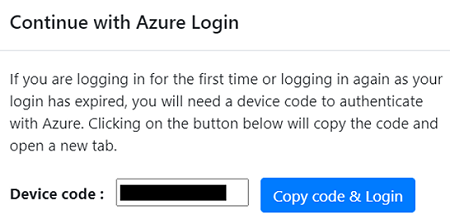
In a new tab in your browser, paste the device code and sign in by using your Azure username and password. Signing in with a PIN isn't supported.
Note
If you close the sign in tab accidentally without logging in, refresh the browser tab of the appliance configuration manager to display the device code and Copy code & Login button.
After you successfully sign in, return to the browser tab that display the appliance configuration manager. If the Azure user account that you used to sign in has the required permissions for the Azure resources that were created during key generation, appliance registration starts.
After the appliance is successfully registered, to see the registration details, select View details.
Install the VDDK: The appliance checks if the VMware vSphere Virtual Disk Development Kit (VDDK) is installed. Download VDDK version 8.0 from the Broadcom Developer portal. After downloading, extract the zip file to the default location: C:\Program Files\VMware\VMware Virtual Disk Development Kit, as mentioned in the installation instructions.
The Azure Migrate: Server Migration tool uses the VDDK to replicate servers during migration to Azure.
You can rerun prerequisites at any time during appliance configuration to check whether the appliance meets all the prerequisites.
Start continuous discovery
Complete the setup steps in the appliance configuration manager to prepare for and start discovery.
Provide vCenter Server details
The appliance must connect to vCenter Server to discover the configuration and performance data of the servers:
In Step 1: Provide vCenter Server credentials, select Add credentials to enter a name for the credentials. Add the username and password for the vCenter Server account that the appliance will use to discover servers running on vCenter Server.
- You should have set up an account with the required permissions as described earlier in this article.
- If you want to scope discovery to specific VMware objects (vCenter Server datacenters, clusters, hosts, folders of clusters or hosts, or individual servers), review the instructions to set discovery scope to restrict the account that Azure Migrate uses.
- If you want to add multiple credentials at once, select Add more to save and add more credentials. Multiple credentials are supported for discovery of servers across multiple vCenter Servers using a single appliance.
In Step 2: Provide vCenter Server details, select Add discovery source to add the IP address or FQDN of a vCenter Server. You can leave the port as the default (443) or specify a custom port on which vCenter Server listens. Select the friendly name for credentials you would like to map to the vCenter Server and select Save.
Select Add more to save the previous details and add more vCenter Server details. You can add up to 10 vCenter Servers per appliance.
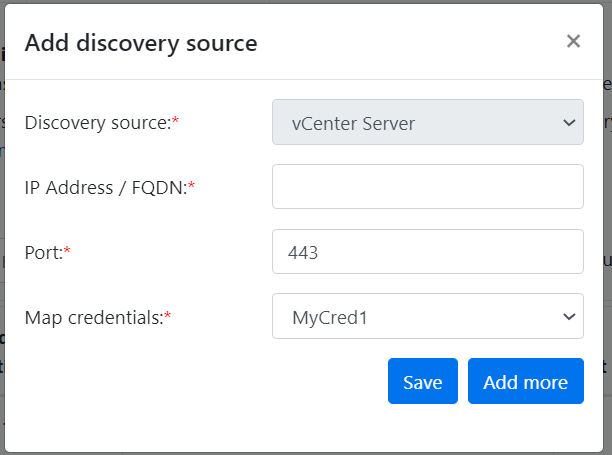
The appliance attempts to validate the connection to the vCenter Server(s) added by using the credentials mapped to each vCenter Server. It displays the validation status with the vCenter Server(s) IP address or FQDN in the sources table.
You can revalidate the connectivity to the vCenter Server(s) anytime before starting discovery.
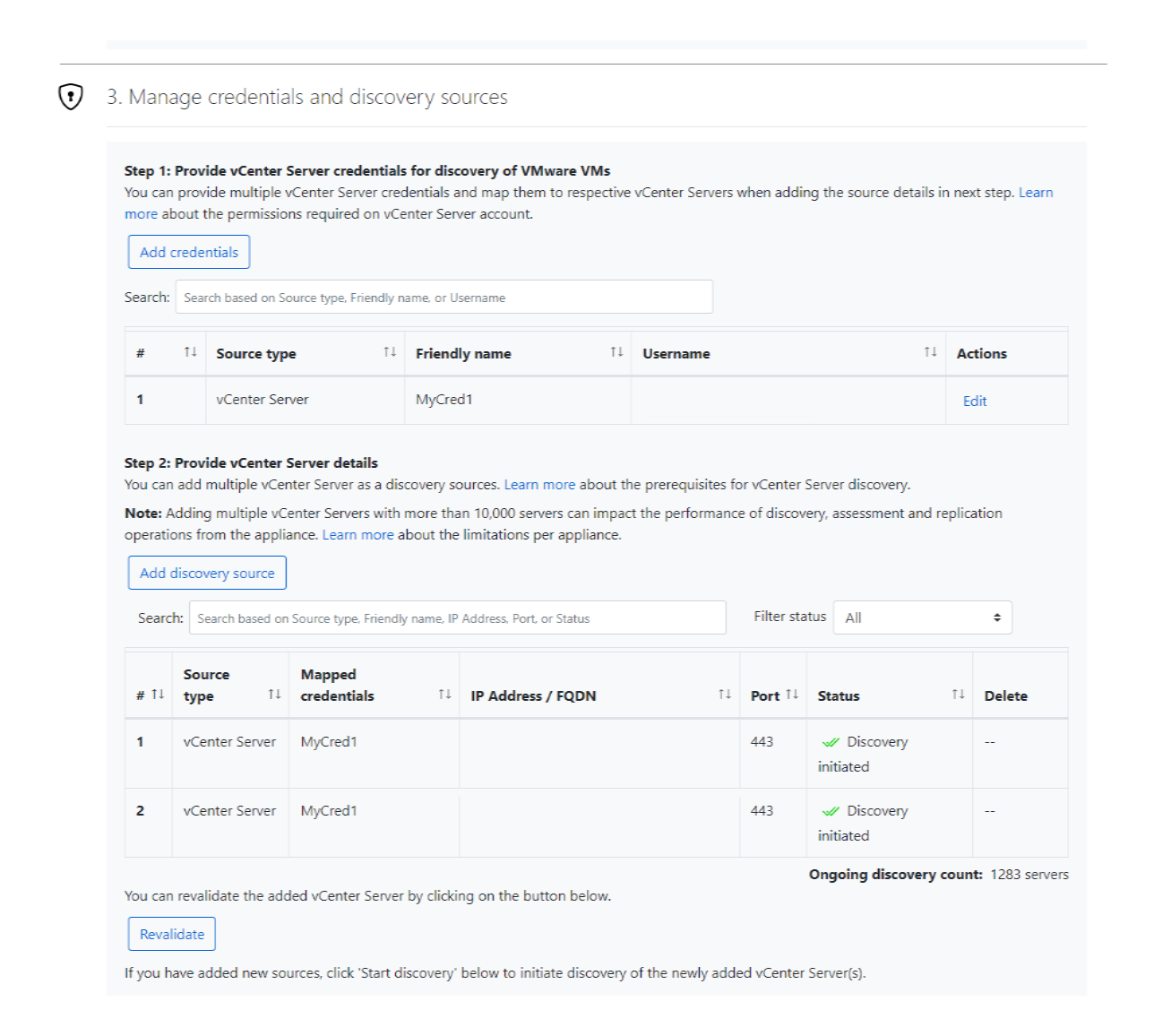
Provide server credentials
In Step 3: Provide server credentials to perform software inventory, agentless dependency analysis, discovery of SQL Server instances and databases and discovery of web apps in your VMware environment., you can provide multiple server credentials. If you don't want to use any of these appliance features, you can skip this step and proceed with vCenter Server discovery. You can change this option at any time.

If you want to use these features, provide server credentials by completing the following steps. The appliance attempts to automatically map the credentials to the servers to perform the discovery features.
To add server credentials:
Select Add Credentials.
In the dropdown menu, select Credentials type.
You can provide domain, Windows(non-domain), Linux(non-domain), Linux (SSH-key), and SQL Server authentication credentials. Learn how to provide credentials and how we handle them.
For a Windows server:
- Select the source type as Windows Server.
- Enter a friendly name for the credentials.
- Add the username and password.
- Select Save.
If you use password-based authentication for a Linux server, select the source type as Linux Server (Password-based).
- Enter a friendly name for the credentials.
- Add the username and password, and then select Save.
If you use SSH key-based authentication for a Linux server:
- Select the source type as Linux Server (SSH key-based).
- Enter a friendly name for the credentials.
- Add the username.
- Browse and select the SSH private key file.
- Select Save.
Note
- Azure Migrate supports SSH private keys created using the ssh-keygen command with RSA, ECDSA, and ed25519 algorithms.
- It supports SSH private key files in OpenSSH format.
- It doesn't support SSH keys with a passphrase. We recommend using a key without a passphrase
- It also doesn't support SSH private key files created by PuTTY.
Note
- To discover servers using passwords, the Azure Migrate appliance uses VMware tools and vSphere APIs to collect software inventory and dependency analysis data.
- To discover Linux servers using SSH key-based authentication, the appliance needs a direct connection to the target servers. It connects through SSH to gather software inventory and agentless dependency analysis information.
If you choose to use domain credentials, you also must enter the FQDN for the domain. The FQDN is required to validate the authenticity of the credentials with the Active Directory instance in that domain.
Review the required permissions on the account for discovery of installed applications, agentless dependency analysis, and discovery of web apps and SQL Server instances and databases.
To add multiple credentials at once, select Add more to save credentials, and then add more credentials.
When you select Save or Add more, the appliance validates the domain credentials with the domain's Active Directory instance for authentication. Validation is made after each addition to avoid account lockouts as the appliance iterates to map credentials to respective servers.
To check validation of the domain credentials:
In the configuration manager, in the credentials table, see the Validation status for domain credentials. Only domain credentials are validated.
If validation fails, you can select a Failed status to see the validation error. Fix the issue, and then select Revalidate credentials to reattempt validation of the credentials.
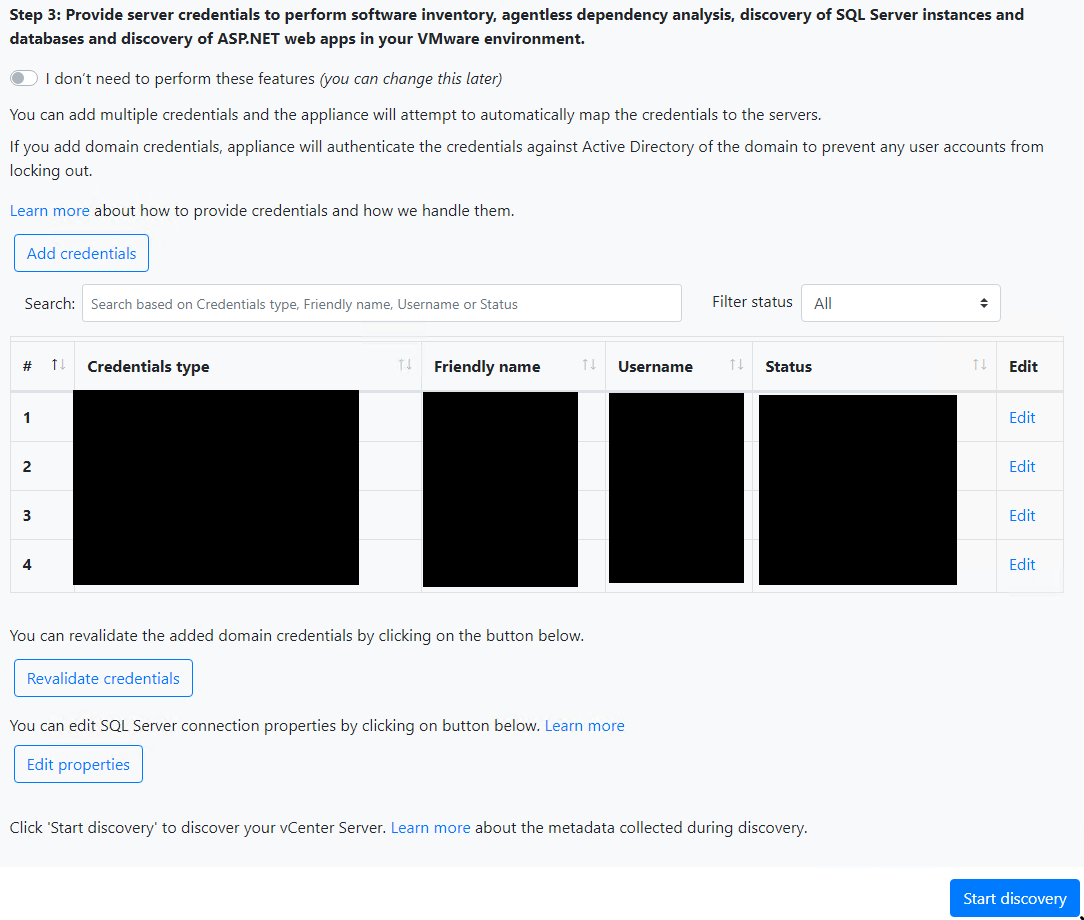
Start discovery
To start vCenter Server discovery, select Start discovery. After the discovery is successfully initiated, you can check the discovery status by looking at the vCenter Server IP address or FQDN in the sources table.
How discovery works
It takes approximately 20-25 minutes for the discovery of servers across 10 vCenter Servers added to a single appliance.
If you have provided server credentials, software inventory (discovery of installed applications) is automatically initiated when the discovery of servers running on vCenter Server(s) is finished. Software inventory occurs once every 12 hours.
Software inventory identifies the SQL Server instances that are running on the servers. Using the information it collects, the appliance attempts to connect to the SQL Server instances through the Windows authentication credentials or the SQL Server authentication credentials that are provided on the appliance. Then, it gathers data on SQL Server databases and their properties. The SQL Server discovery is performed once every 24 hours.
Appliance can connect to only those SQL Server instances to which it has network line of sight, whereas software inventory by itself might not need network line of sight.
Discovery of installed applications might take longer than 15 minutes. The duration depends on the number of discovered servers. For 500 servers, it takes approximately one hour for the discovered inventory to appear in the Azure Migrate project in the portal.
Software inventory identifies web server role existing on discovered servers. If a server is found to have web server role enabled, Azure Migrate will perform web apps discovery on the server. Web apps configuration data is updated once every 24 hours.
During software inventory, the added server credentials are iterated against servers and validated for agentless dependency analysis. When the discovery of servers is finished, in the portal, you can enable agentless dependency analysis on the servers. Only the servers on which validation succeeds can be selected to enable agentless dependency analysis.
Web apps and SQL Server instances and databases data begin to appear in the portal within 24 hours after you start discovery.
By default, Azure Migrate uses the most secure way of connecting to SQL instances that is, Azure Migrate encrypts communication between the Azure Migrate appliance and the source SQL Server instances by setting the TrustServerCertificate property to
true. Additionally, the transport layer uses TLS to encrypt the channel and bypass the certificate chain to validate trust. Hence, the appliance server must be set up to trust the certificate's root authority. However, you can modify the connection settings, by selecting Edit SQL Server connection properties on the appliance. Learn more to understand what to choose.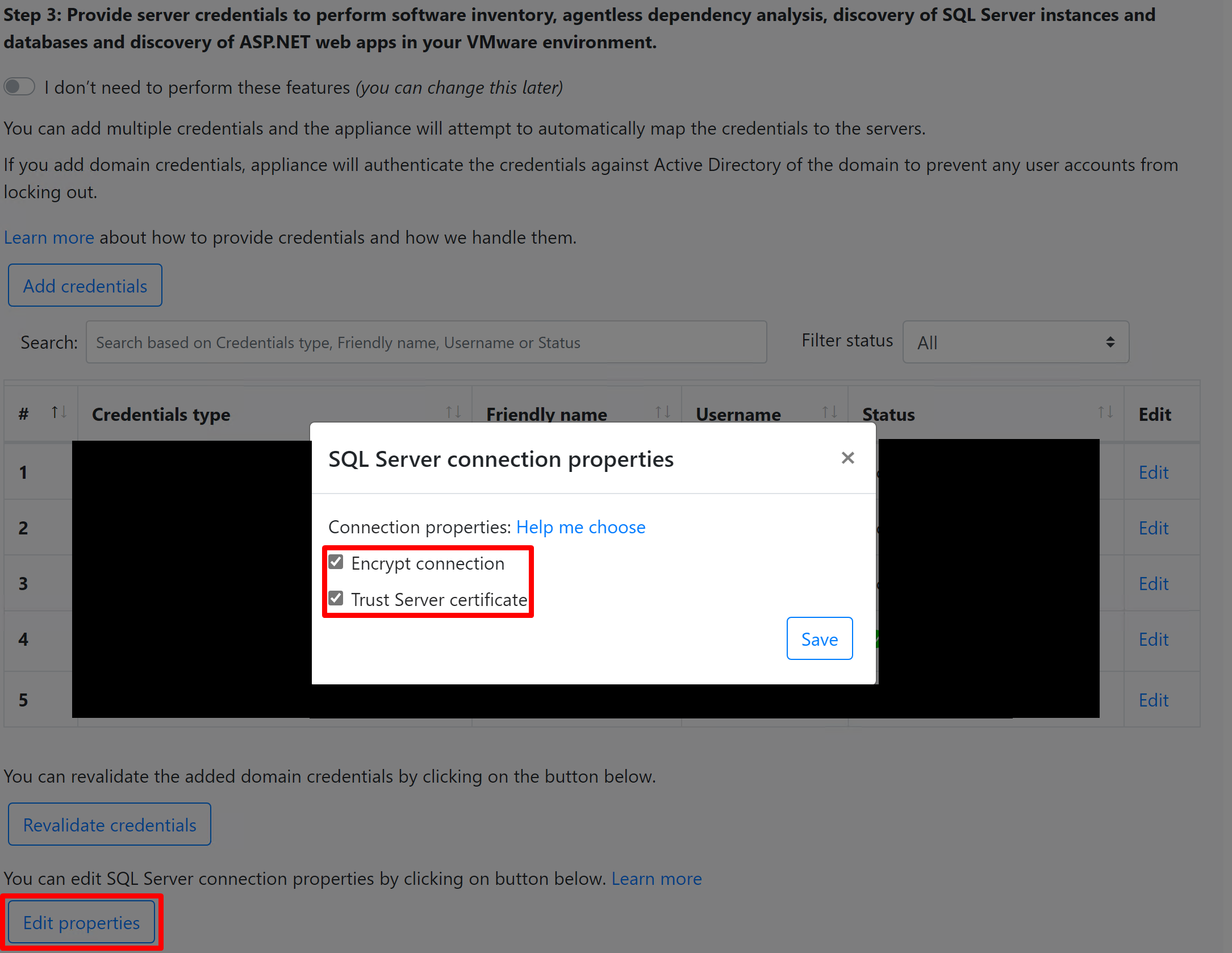
To start vCenter Server discovery, select Start discovery. After the discovery is successfully initiated, you can check the discovery status by looking at the vCenter Server IP address or FQDN in the sources table.
View discovered data
Return to Azure Migrate in the Azure portal.
Select Refresh to view discovered data.
Select the discovered servers count to review the discovered inventory. You can filter the inventory by selecting the appliance name and selecting one or more vCenter Servers from the Source filter.
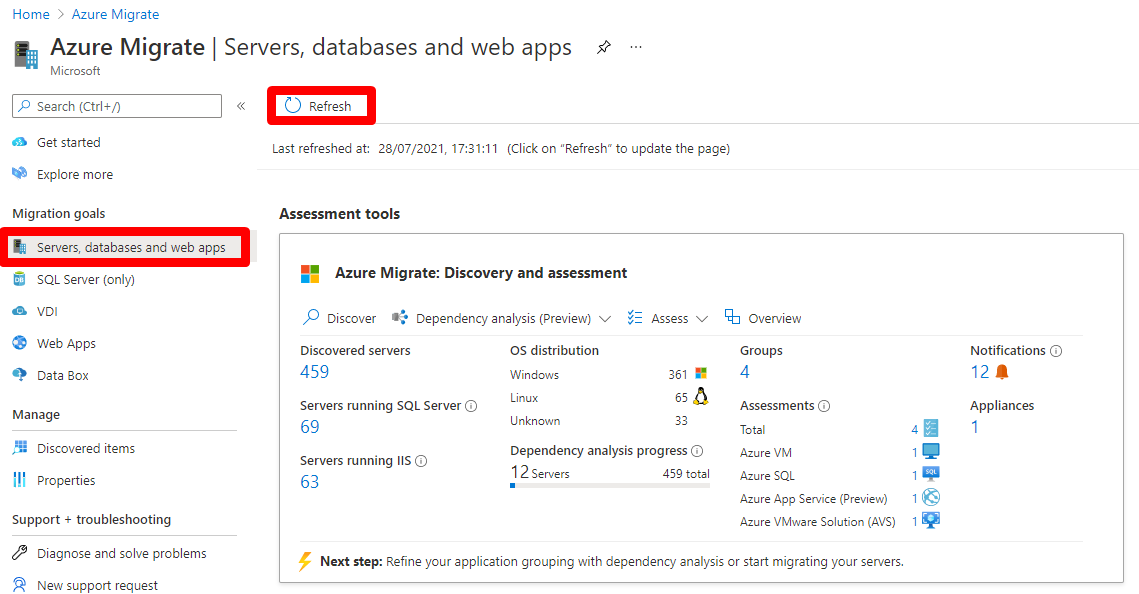
Details such as OS license support status, inventory, database instances, etc. are displayed.
View support status
You can gain deeper insights into the support posture of your environment from the Discovered servers and Discovered database instances sections.
The Operating system license support status column displays the support status of the Operating system, whether it is in mainstream support, extended support, or out of support. Selecting the support status opens a pane on the right, which provides clear guidance regarding actionable steps that can be taken to secure servers and databases in extended support or out of support.
To view the remaining duration until end of support, that is, the number of months for which the license is valid, select Columns > Support ends in > Submit. The Support ends in column displays the duration in months.
The Database instances displays the number of instances discovered by Azure Migrate. Select the number of instances to view the database instance details. The Database instance license support status displays the support status of the database instance. Selecting the support status opens a pane on the right, which provides clear guidance regarding actionable steps that can be taken to secure servers and databases in extended support or out of support.
To view the remaining duration until end of support, that is, the number of months for which the license is valid, select Columns > Support ends in > Submit. The Support ends in column displays the duration in months.
Onboard to Azure Local (optional)
Note
Perform this step only if you are migrating to Azure Local.
Provide the Azure Stack cluster information and the credentials to connect to the cluster. For more information, see Download the Azure Local software.

Next steps
Learn how to assess servers to migrate to Azure VMs.
Review data the Azure Migrate appliance collects during discovery.